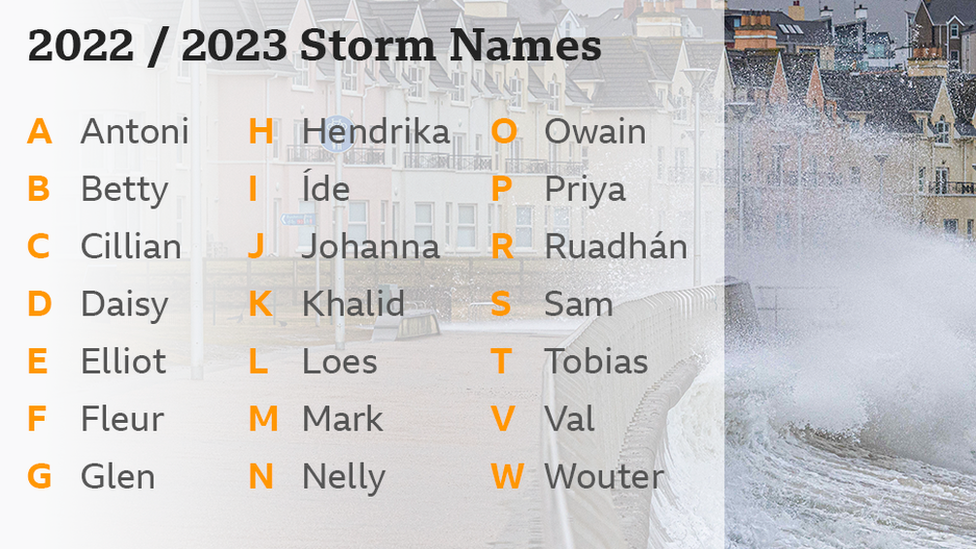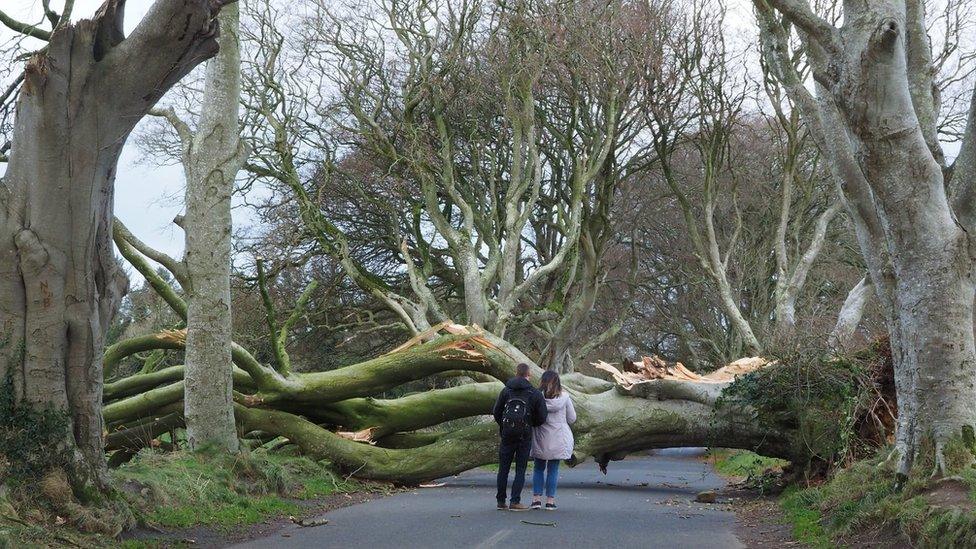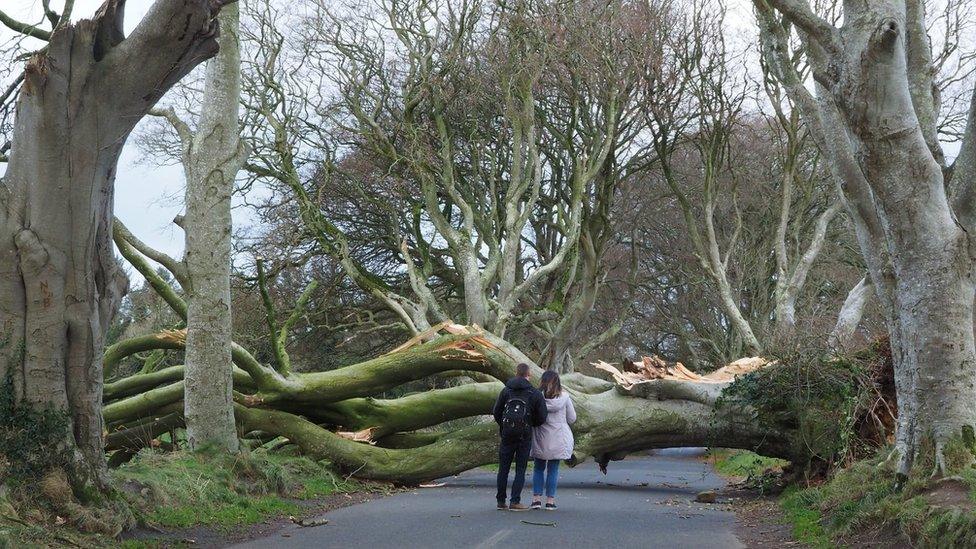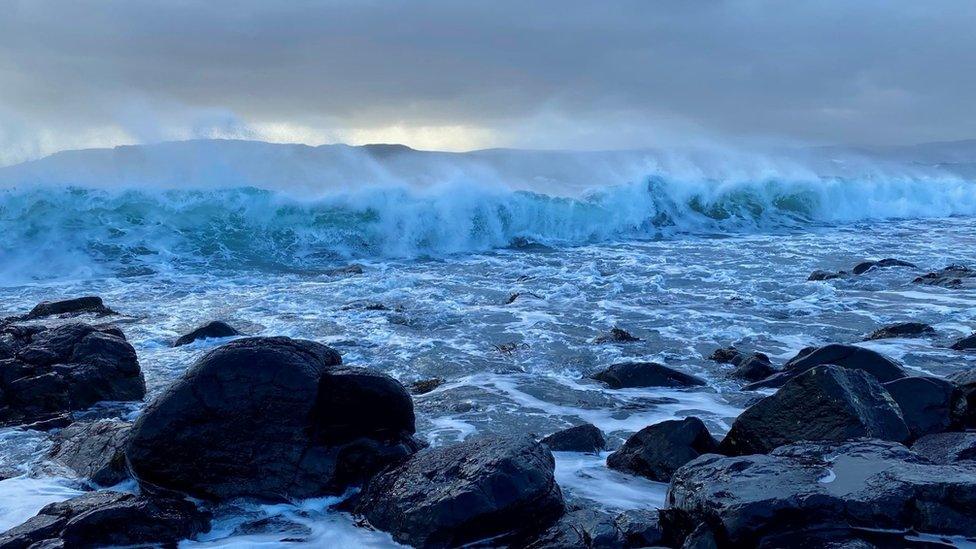Storms: Betty, Cillian and Khalid among this year's names
- Published

Storms named by other countries keep their name if they reach British, Irish or Dutch shores
Betty, Cillian, Glen, Íde and Sam are among the names that will be used for storms that come to Northern Ireland in the next 12 months.
They were announced as part of a joint initiative by the British, Irish and Dutch weather services.
The names are designed to raise awareness of potentially damaging, disruptive and life-threatening severe weather.
Storms are named when they are forecast to cause a medium to high impact.
"Recent impactful storms demonstrated our ongoing need to communicate severe weather in a clear way to help the public protect themselves," said Will Lang, from the Met Office.
"Naming storms is just one way that we know helps to raise awareness of severe weather and provides clarity for the public when they need it most."

Waves battered Portrush on the Antrim coast as Storm Franklin hit
This is the eighth year that storms have been named and follows the 2021/22 season where six systems were named by the organisations.
Antoni will be the first named storm of the new season to hit the UK, Ireland or the Netherlands.
The Met Office's names in the list have come through submissions from the public, with Daisy, Glen, Khalid and Owain among those submitted.
Storm names set as meteorological autumn begins
Betty was winner of a public vote on the Met Office's Twitter, with more than 12,000 votes cast to select the name for the letter B.
KNMI's selected names, including Antoni, Hendrika, Johanna and Loes, are named after influential Dutch scientists, while Met Éireann's submissions include Cillian, Fleur, Íde and Nelly.
"The annual unveiling of the new storm names creates great media and public interest," said Evelyn Cusack, from Met Éireann.
"More importantly, though, during the winter when a storm is named for potential impacts, it creates a great media and public call to action, helping to save lives and property."

Head of Forecasting at KNMI, Jan Rozema, said: "Chances are very high that severe storms will affect all three countries involved: Ireland, the UK and the Netherlands.
"News on severe weather is not limited to national boundaries, so the message to UK, Irish and Dutch inhabitants will be much appreciated and understood if we share the same information, starting with storm names."

Storm Arwen did serious damage to County Antrim's famous Dark Hedges
Storm Arwen was the first to move in last year, on 26 and 27 of November, bringing severe conditions.
County Antrim school principal, Francis Lagan, was killed when a tree fell on his car during the strong winds.
There were also power cuts, damage, travel disruption, and some of the trees at County Antrim's famous Dark Hedges fell.
It was "undoubtedly one of the most damaging wind storms of the latest decade", according to the Met Office.
Storm Barra then brought further damage and disruption when it struck on 7 and 8 of December.
Warnings were issued across the island of Ireland with the most severe - red - towards the south west.
Yellow warnings were issued ahead of Storm Corrie which moved in at the end of January, bringing strong winds towards the north coast.
The stormy season concluded with three storms in the space of a week.
Storm Dudley hit on 16 February, Storm Eunice on 18 February, and Storm Franklin on 20 February.

Storm Dudley was one of three storms to strike in a single week in February
This was this first time this has happened since storms started to be given names in 2015-16.
Yellow warnings were issued across Northern Ireland and the Republic of Ireland ahead of Storm Dudley before an amber warning - the second highest level - was issued for counties Antrim and Londonderry.
One man died when he was hit by a falling tree while cleaning storm debris in County Wexford during Storm Eunice two days later.
Snow and high winds also brought disruption to parts of Northern Ireland.
Severe flooding followed Storm Eunice and the clean-up operation was affected when Storm Franklin arrived on 20 February.
That storm brought damage to properties, travel disruption and thousands of properties lost their power supplies.
The letters Q, U, X, Y and Z are not used to fit with international storm-naming conventions.
Other European countries to name impactful storms include France, Spain and Portugal in south west Europe, and Sweden, Norway and Denmark in northern Europe.
Storms named by other countries keep their name if they reach British, Irish or Dutch shores.
Related topics
- Published1 September 2021

- Published27 November 2021

- Published7 December 2021

- Published30 January 2022
